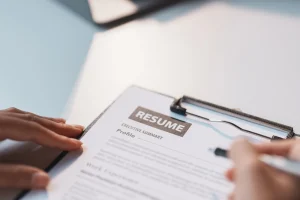Climbing the corporate ladder to secure a C-level position—whether as a CEO, CFO, COO, or CTO—requires more than just stellar leadership and a proven track record of success. It begins with a powerful resume that showcases your ability to deliver results, lead strategic initiatives, and shape the future of an organization. Unlike a mid-level resume, a C-level resume isn’t about listing responsibilities. It’s about highlighting your leadership impact, vision, and the measurable results you’ve achieved throughout your career.
Your resume is your personal marketing tool, and for executive roles, it needs to reflect authority, expertise, and strategy. If you’ve been wondering, “What are the best tips for writing a C-level resume?”, you’re in the right place. This guide will walk you through everything you need to craft a resume that grabs the attention of recruiters, executive search firms, and board members.

What Makes a C-Level Resume Different?
A C-level resume is fundamentally different from those used for entry-level or mid-level positions. While most resumes focus on tasks and responsibilities, an executive resume emphasizes leadership achievements and the value you’ve delivered to organizations.
Key differences include:
- Strategic Focus: C-level resumes highlight big-picture thinking and the ability to drive organizational growth and change.
- Quantifiable Achievements: Numbers, KPIs, and metrics matter. Revenue growth, cost savings, mergers, acquisitions, and market expansions must be showcased.
- Tailored for Leadership: Recruiters expect to see evidence of executive decision-making, board-level influence, and the ability to inspire teams.
- Concise Yet Impactful: A C-level resume is typically 2 pages but packs a punch with strong action verbs and concise leadership statements.
- Branding: At this level, you are not just a candidate—you are a brand. A C-level resume highlights a clear executive brand statement.
These differences are especially important for those targeting C-level positions within the C-suite, as they must demonstrate the leadership, soft skills, and strategic agility expected of C-level executives and C-suite roles in today’s dynamic business environment.
Key Elements Every C-Level Resume Must Have
Before diving into actionable tips, it’s crucial to understand the essential components of a strong executive resume:
1. A Compelling Executive Summary
Forget the traditional “objective statement.” Your executive summary should act as your elevator pitch, summarizing your leadership experience, industry expertise, and career highlights in 3–5 sentences. For example:
“Dynamic Chief Financial Officer with over 15 years of experience driving multi-million-dollar revenue growth, leading M&A initiatives, and delivering financial strategies that align with corporate objectives. Recognized for building high-performing teams and spearheading transformative cost-reduction measures.”
2. Core Competencies and Skills
Include a skills section that reflects your areas of expertise—think of executive-level competencies like both hard skills and soft skills, as these are essential for standing out to hiring managers and boards. For example:
- Business transformation
- Strategic planning
- Global operations
- Corporate finance
- Change management
- Stakeholder engagement
- Risk management
- Hard skills such as data analysis, financial modeling, or technology implementation
Demonstrating a diverse skill set, including both hard and soft skills, is crucial for executive roles and will help your resume align with modern organizational demands.
3. Results-Driven Professional Experience
Each role should go beyond listing duties. Focus on relevant experience and career progression. Use accomplishment-based bullet points with measurable results:
- “Increased revenue by 35% within two years by implementing strategic partnerships and expanding global operations.”
Highlight your current job or current position at the top of your resume to showcase your most recent responsibilities and demonstrate ongoing career progression.
- “Reduced operational costs by $10M annually through a comprehensive process optimization strategy.”
Including specific examples and clear job titles from your work history and past employers helps demonstrate your impact and leadership in each role.
4. Education and Certifications
Highlight advanced degrees such as an MBA, EMBA, or other graduate programs that strengthen your executive credibility. Include relevant leadership training, professional licenses, or certifications like Six Sigma, PMP, or Lean Management, as these demonstrate strategic thinking and operational expertise.
If you have attended executive leadership programs or seminars (e.g., Harvard Business School Executive Education), mention them to show your commitment to continuous growth.
5. Executive Branding and Design
A C-level resume should project a polished and modern professional image. Use a clean, uncluttered layout with strategic formatting—bold headings, clear sections, and bullet points—to make your key achievements stand out. Incorporate subtle design elements like selective use of color or spacing to create visual appeal without overwhelming the content.
The goal is to present a document that is both easy to read and aligned with your executive brand, reflecting sophistication and attention to detail.
10 Essential Tips for Writing a C-Level Resume
When it comes to tips for writing a C-level resume?, you need more than generic advice. You must focus on creating a strong resume that highlights your leadership and business impact, while appealing directly to potential employers. Below are proven strategies that can transform your resume into a powerful career tool.
Additionally, aligning your resume with keywords from relevant job postings can significantly improve your chances of being noticed by hiring managers and passing through Applicant Tracking Systems.
1. Start with a Strong Executive Summary
Your opening statement sets the tone. Make it concise but powerful by highlighting your leadership philosophy, key achievements, and expertise. Avoid overused clichés like “results-oriented professional”—focus on unique strengths that differentiate you.
2. Use a Leadership-Driven Tone
Unlike resumes for mid-level roles, a C-level resume must reflect authority. Use action verbs that demonstrate leadership:
- Orchestrated
- Spearheaded
- Transformed
- Pioneered
- Directed
- Engineered
3. Highlight Quantifiable Achievements
Recruiters want to see evidence of success. Use metrics like:
- Revenue growth percentages
- Cost savings in dollars
- Market share expansion
- Successful M&A deals
- Number of employees managed
- Profit margin improvements
- Improvements in operational efficiency
For example:
- “Pioneered a digital transformation strategy that increased revenue by 40% and reduced operational inefficiencies by 25% within 18 months.”
Demonstrating data driven decision making and leveraging technology to achieve results is highly valued in C-level roles.
4. Tailor Your Resume for Each Role
Generic resumes fail at the executive level. Research each company’s goals and challenges, and align your achievements with their needs. Use industry-specific keywords to optimize your resume for applicant tracking systems (ATS).
5. Showcase Executive Leadership Competencies
Highlight high-level competencies like:
- Organizational restructuring
- Corporate governance
- Crisis management
- International market penetration
- Innovation and digital transformation
- Developing and implementing strategic plans
- Optimizing business operations for efficiency and growth
- Leading human resources initiatives to foster talent and culture
- Applying critical thinking to solve complex challenges
6. Keep It Concise but Impactful
Even if your career spans decades, your resume should remain focused and sharp—ideally no longer than two pages. Prioritize the last 10–15 years of experience, as this period is often the most relevant to executive recruiters. Highlight only your most influential roles and accomplishments that demonstrate leadership, transformation, or strategic growth. Every bullet point should earn its place by showcasing measurable results.
7. Emphasize Your Unique Value Proposition
Your resume should clearly communicate what sets you apart from other C-level candidates. Are you known for leading successful IPOs, driving mergers and acquisitions, or turning struggling divisions into profitable ventures? Define your unique executive brand and ensure it’s reflected throughout your resume. Use compelling language that positions you as a visionary leader with a track record of success.
8. Incorporate Board and Investor Relations
If you have collaborated with boards of directors, investors, or shareholders, highlight these experiences prominently. C-level roles often require strong governance knowledge and the ability to influence key stakeholders. Show that you understand corporate accountability, strategic decision-making, and how to build trust with high-level partners.
9. Avoid Overloading with Technical Details
While technical expertise can add value, your focus as an executive is on strategy, vision, and leadership. Avoid listing overly technical skills unless they directly reinforce your ability to lead innovation or transformation. Instead, emphasize how you leverage technical insights to shape business strategy and drive organizational success.
10. Use a Modern, Professional Design
Your resume’s design should reflect your executive presence. Use clean, professional fonts like Calibri, Garamond, or Helvetica, combined with strategic white space and bold headings to improve readability. A subtle touch of color or a well-structured layout can make your resume stand out—without sacrificing the professional tone expected at the C-level.
How to Showcase Your Achievements Effectively
Achievements are the lifeblood of a C-level resume. To stand out, you must quantify your impact and present results in a way that demonstrates strategic value. Strong achievements should also reflect leadership skills, such as driving team performance, earning professional awards, or being recognized for your influence in previous roles.
Example Transformation:
- Weak: “Responsible for managing budgets.”
- Strong: “Directed $500M annual budgets, reducing expenses by 15% through cross-departmental collaboration and streamlined vendor contracts.”
Pro Tip: Use the CAR formula (Challenge, Action, Result) for each bullet point:
- Challenge: What was the problem or opportunity?
- Action: What did you do to address it?
- Result: What measurable outcome did you achieve?
Instead of using generic phrases like ‘excellent communication skills,’ provide specific examples that demonstrate your communication and leadership abilities, such as leading cross-functional teams or presenting key strategies to stakeholders.
Why Executive Branding Matters
At the C-level, you’re not just applying for a job—you’re positioning yourself as a thought leader and a strategic partner. Executive branding is about clearly defining what sets you apart.
How to Build a Strong Executive Brand:
- Define your unique leadership philosophy.
- Highlight consistent career themes, such as innovation, turnaround expertise, or market expansion.
- Ensure your resume, LinkedIn, and cover letter tell a cohesive story.
Leveraging LinkedIn Alongside Your Resume
Recruiters and executive search firms often review LinkedIn profiles before even reading resumes. A powerful LinkedIn presence complements your C-level resume and reinforces your credibility.
Key LinkedIn Tips for Executives:
- Use the same branding tone as your resume in your headline and summary.
- Share thought leadership content to build authority.
- Highlight accomplishments with metrics, similar to your resume.
Common Mistakes to Avoid in C-Level Resumes
Even experienced executives make critical mistakes when writing their resumes. Here’s what you must avoid:
- Listing Job Duties Instead of Achievements: Your resume isn’t a job description. Focus on outcomes and results.
- Being Too Vague: Avoid generic terms like “responsible for” or “managed”. Instead, use action-driven statements that showcase success.
- Using an Outdated Format: Old-fashioned templates and dense text blocks won’t make a strong impression.
- Skipping Keywords: Even C-level resumes pass through ATS filters, so use keywords relevant to the industry and role.
- Overloading with Information: A resume isn’t your entire career history—only include what positions you as the best fit, with an emphasis on career progression rather than listing every job.
- Ignoring Soft Skills: While hard metrics are essential, leadership, communication, and vision should also come through.
- Failing to Demonstrate Cultural Fit: Employers want to see that you align with their company values and work environment, especially for executive roles.
- Not Tailoring Your Resume to Specific Jobs: Customize your resume to highlight relevant experience and skills for the particular jobs you are targeting.
Ready to Elevate Your Executive Career?
Don’t leave your future to chance. Partner with us to craft a powerful, tailored C-level resume that showcases your leadership, achievements, and unique value. Our expert C-level resume writers specialize in executive resumes that get noticed by recruiters and board members alike.
Take the next step—contact us today and secure your place at the top.
Frequently Asked Questions
Should I include a photo on my C-level resume?
Generally, it’s not recommended to include a photo unless you’re applying in regions where it’s standard practice (e.g., parts of Europe or Asia). In most cases, U.S. and Canadian employers prefer resumes without photos to avoid potential biases. Focus instead on strong branding through content and achievements.
How important is a cover letter for C-level applications?
A well-crafted cover letter can significantly enhance your application. It allows you to provide context for your career achievements, explain career transitions, and highlight why you are uniquely positioned for the role. For C-level roles, a tailored, story-driven cover letter often makes a strong impression.
Can I include non-executive volunteer experience?
Yes, but only if it aligns with your leadership profile. For example, serving on a nonprofit board, leading fundraising initiatives, or mentoring professionals are great ways to showcase executive-level leadership and community involvement.
How do I handle employment gaps on an executive resume?
Focus on accomplishments and value creation during the gap, such as consulting projects, board memberships, or continued education. Be transparent, but frame the gap in a way that reflects growth or strategic career moves.
Should I use an executive bio alongside my resume?
Yes. An executive bio is often used in addition to a resume for networking, board applications, or investor meetings. It provides a more narrative and high-level overview of your career and is a great complement to your resume when targeting high-stakes executive roles.








